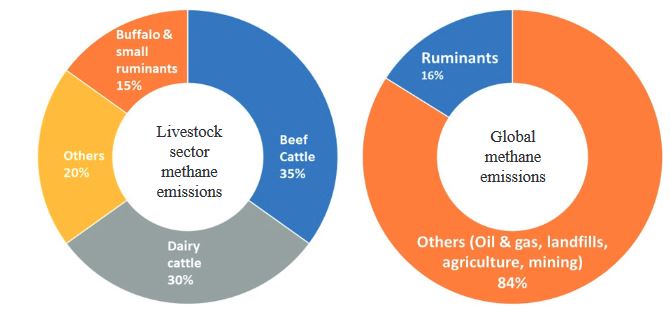Rumen environmental and nutritional strategies to mitigate emissions from livestock
Main Article Content
Abstract
Methane is the single largest greenhouse gas produced by ruminants, 28-times the warming effect of carbon dioxide. Methane is a by-product of the anaerobic fermentation of carbohydrates and amino acids in the rumen to a lesser extent. It is produced by archaea, and it is considered a loss of feed energy that could otherwise be used for productivity. Economic progress and the world’s growing population will increase meat and milk product demands; when ruminant livestock increase, methane production increases, accelerating global warming in the process inevitably. A massive worldwide research effort has investigated various mitigation strategies that can be grouped into three categories: animal and feed management, diet formulation, and rumen manipulation. These approaches affect directly or indirectly the rumen microbiome thereby reducing rumen methanogenesis. The strategy is to improve forage quality or change the forage type or proportion or add supplements such as probiotics, oils, and enzymes that either reduce methanogenesis or shift the metabolic pathways leading to the H2 reduction as a useful substrate. Methanogens community composition rather than its size seems correlated to methane production and the diversity is influenced by H2 availability and interactions within and between H2-producing microbes in the rumen, so research needs to study the different mechanisms of methanogenesis according to dietary and environmental conditions in different ruminants’ species.
Keywords: GHG mitigation strategies, methane, methanogenesis, rumen microbiome
Article Details
Those authors that have publications with this journal accept the following terms:
1. They will retain their copyright and guarantee the journal the right of first publication of their work, which will be simultaneously subject to the License Creative Commons Attribution-NonCommercial 4.0 International (CC BY-NC 4.0) that allows third parties to share the work whenever its author is indicated and its first publication this journal. Under this license the author will be free of:
- Share — copy and redistribute the material in any medium or format
- Adapt — remix, transform, and build upon the material
- The licensor cannot revoke these freedoms as long as you follow the license terms.
Under the following terms:
- Attribution — You must give appropriate credit, provide a link to the license, and indicate if changes were made. You may do so in any reasonable manner, but not in any way that suggests the licensor endorses you or your use.
- NonCommercial — You may not use the material for commercial purposes.
- No additional restrictions — You may not apply legal terms or technological measures that legally restrict others from doing anything the license permits.
2. The authors may adopt other non-exclusive license agreements to distribute the published version of the work (e.g., deposit it in an institutional telematics file or publish it in a monographic volume) whenever the initial publication is indicated in this journal.
3. The authors are allowed and recommended disseminating their work through the Internet (e.g. in institutional telematics archives or on their website) before and during the submission process, which can produce interesting exchanges and increase the citations of the published work. (See the Effect of open access).
